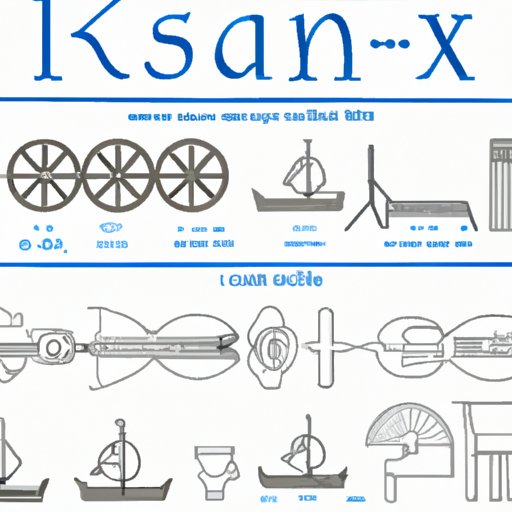Introduction
The Sumerians were an ancient Mesopotamian people who lived in what is now Iraq and Iran. They established one of the earliest known civilizations in the world, with a rich culture that spanned centuries. From their development of cuneiform writing to their pioneering advances in agriculture and architecture, the Sumerians left an indelible mark on history. This article will explore the various inventions of the Sumerians, analyzing their lasting impact on modern society.

Historical Overview of Sumerian Inventions
The Sumerians developed a variety of technologies that shaped their everyday life. These included advancements in agriculture, architecture, medicine, and more. For instance, they invented the plow, which allowed them to cultivate larger areas of land with greater efficiency. They also created terraced fields and canals for irrigation, which greatly improved their agricultural output.
In terms of architecture, the Sumerians built mud brick homes and temples, as well as the first known ziggurats—stepped pyramids made of mud brick. In addition, they developed mathematical techniques for surveying land, building projects, and other engineering tasks. They also developed a system of weights and measures for trading goods, as well as a form of writing called cuneiform.

Exploring the Impact of Sumerian Technology on Modern Society
The inventions of the Sumerians have had a profound impact on modern society. For example, their cuneiform writing system laid the foundations for modern alphabets. In addition, their developments in mathematics and engineering have been invaluable in the advancement of modern technology.
The Sumerians’ inventions have also had a significant influence on modern construction, transportation, communication, and other aspects of daily life. Their use of the wheel, for instance, has revolutionized transportation, while their irrigation systems have enabled the growth of agriculture in arid climates.
Analyzing the Most Notable Sumerian Inventions
One of the most notable inventions of the Sumerians was cuneiform writing. This system used pictographs and symbols to represent objects and ideas, and it was later adapted by the Akkadians and Babylonians. Cuneiform is considered one of the earliest forms of written language, and it was used for a variety of purposes, including record-keeping and religious ceremonies.
The Sumerians also invented the wheeled vehicle, which was used for transportation and other tasks. While earlier civilizations had used rollers to move heavy objects, the Sumerians were the first to attach these rollers to a frame, creating the precursor to the modern wheel.
The Sumerians are also credited with inventing sailing ships. These vessels were constructed using wood and reeds, and they allowed the Sumerians to travel further than ever before. The Sumerians also developed irrigation systems, which allowed them to better control the flow of water for agricultural purposes.
Examining the Significance of Sumerian Inventions in Ancient Times
The inventions of the Sumerians had a major impact on their everyday life. Their use of cuneiform writing enabled them to keep records and communicate over long distances. Similarly, their wheeled vehicles allowed them to transport goods quickly and efficiently. And their irrigation systems enabled them to grow crops in previously arid areas.
In addition, the inventions of the Sumerians had important social and economic implications. The development of cuneiform writing, for instance, enabled the Sumerians to maintain legal records, which helped to ensure fairness in trade and commerce. Similarly, the invention of the wheeled vehicle allowed merchants to transport their goods more easily and make greater profits.

Investigating How the Sumerians Developed Innovative Technologies
The Sumerians were highly advanced in mathematics and engineering. They developed new tools and techniques that enabled them to build complex structures, such as their famous ziggurats. They also developed sophisticated systems of measurement and calculation, which enabled them to accurately survey land and construct buildings.
The Sumerians’ knowledge of astronomy also played a role in their technological advancements. By studying the stars, they were able to determine the best times for planting and harvesting crops, as well as the optimal paths for sailing ships.
Comparing Sumerian Inventions to Those of Other Ancient Civilizations
The Sumerians were not the only ancient civilization to make significant contributions to technology. Other ancient cultures, such as the Egyptians and the Chinese, also developed innovative technologies. However, there are some notable differences between the two. For instance, while the Egyptians relied heavily on manual labor, the Sumerians developed sophisticated tools and techniques to make their work easier.
In addition, the Sumerians developed a wide range of practical inventions, such as their wheeled vehicles and sailing ships. These inventions were not only useful in everyday life, but they also enabled the Sumerians to expand their reach and interact with other cultures.
Examining the Legacy of Sumerian Inventions in Today’s World
The inventions of the Sumerians continue to have an impact on modern society. Their cuneiform writing system is still used in some parts of the world, and their wheeled vehicles and sailing ships have become ubiquitous. In addition, their advances in mathematics and engineering are still being applied in the development of new technologies.
The Sumerians’ irrigation systems are still used today, allowing farmers to grow crops in otherwise inhospitable climates. And their contributions to architecture and construction are still evident in the modern world, from skyscrapers to bridges.
Conclusion
The ancient Sumerians were a remarkable civilization, renowned for their many contributions to technology. From the invention of cuneiform writing to the development of wheeled vehicles and sailing ships, the Sumerians left an indelible mark on history. Their inventions had a profound impact on ancient times, and their legacy is still felt in today’s world.
(Note: Is this article not meeting your expectations? Do you have knowledge or insights to share? Unlock new opportunities and expand your reach by joining our authors team. Click Registration to join us and share your expertise with our readers.)
